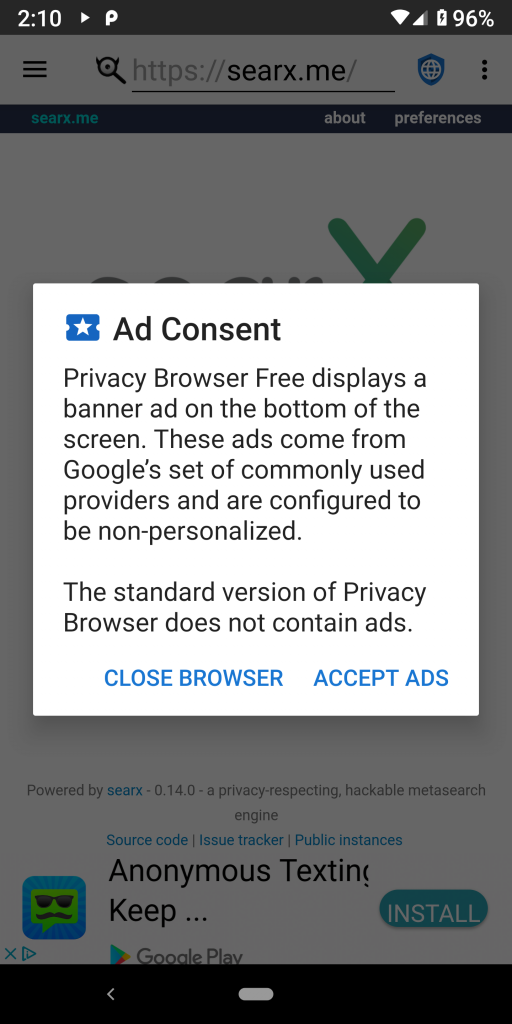Privacy Browser 2.15 features the removal of Google’s Ad Consent library from the free flavor. This was added in Privacy Browser 2.10 to comply with the GDPR. It was never included in the standard flavor.
The Ad Consent library performed two functions. The first of which was to determine if a user was located in Europe. If so, an ad consent dialog was displayed. If the user was not located in Europe, ad consent is not legally required so the dialog was skipped and the ads were loaded.
The second function was to specify users as under-age, which causes all ads to be non-personalized and not include “remarketing”. I am not certain what Google means by that, but they do include this partial explanation on their website: “TFUA disables requests to third-party ad technology providers, such as ad measurement pixels and third-party ad servers”.
Without the ad consent library, it is only possible to set ads to be non-personalized. All app ads in Privacy Browser Free are set to be non-personalized. Note that Google has a fairly personalized definition of non-personalized.
Google considers ads to be personalized when they are based on previously collected or historical data to determine or influence ad selection, including a user’s previous search queries, activity, visits to sites or apps, demographic information, or location. Specifically, this would include, for example: demographic targeting, interest category targeting, remarketing, targeting Customer Match lists, and targeting audience lists uploaded in DoubleClick Bid Manager or Campaign Manager.
Non-personalized ads are ads that are not based on a user’s past behavior. They are targeted using contextual information, including coarse (such as city-level) geo-targeting based on current location, and content on the current site or app or current query terms. Google disallows all personalized targeting, including demographic targeting and user list targeting.
This explanation is written for webpage ads as well as app ads. Google does not have access to the URL that is being visited in Privacy Browser (they better not, anyway). But the advertisers do know that Privacy Browser Free is making the request, and they know things like city-level location.
With the removal of the Ad Consent library, all users of Privacy Browser Free will be shown the ad consent dialog. This complies with the GDPR and doesn’t require that Google attempt to determine if a user is in Europe every time the app launches (although they will do so anyway when they load an ad).
This removes the ability to specify users as under age. The irony of using a tracking library to specify that a user does not want to be tracked is not lost on me. Some may consider it futile to remove one Google library when Privacy Browser Free is still using Google’s Firebase Ads library to display ads and is built using Google’s Android suite of libraries and build tools to run on Android. Ultimately, my decision was made based on a desire to minimize my exposure to Google’s libraries beyond the standard Android toolchain. I would eventually like to replace the Firebase Ads library, but I will only do so when I find an ad network that I can independently verify takes user privacy seriously.
Beginning with Privacy Browser Free 2.15, all users will be show the following ad consent dialog when they launch the app for the first time.


2 responses to “Removal of Google’s Ad Consent Library”
[…] Consent library has been removed from the free flavor. This is significant enough that there is a separate blog post about […]
[…] dropped significantly when the passage of the GDPR gave me the option of forcing all the ads to be non-personalized. I have considered getting rid of the free flavor entirely, but I feel like it provides a nice way […]